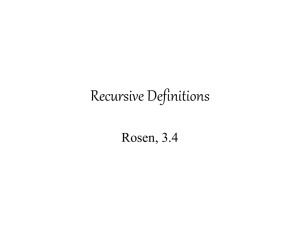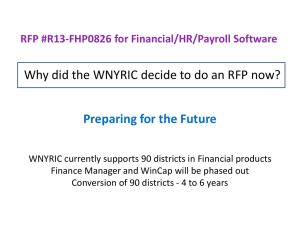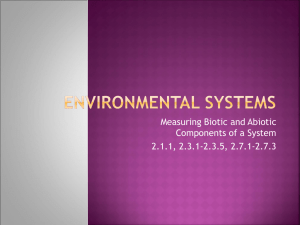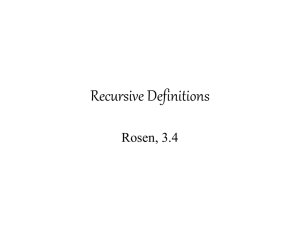Writing Recursive and Closed Formulas for
advertisement
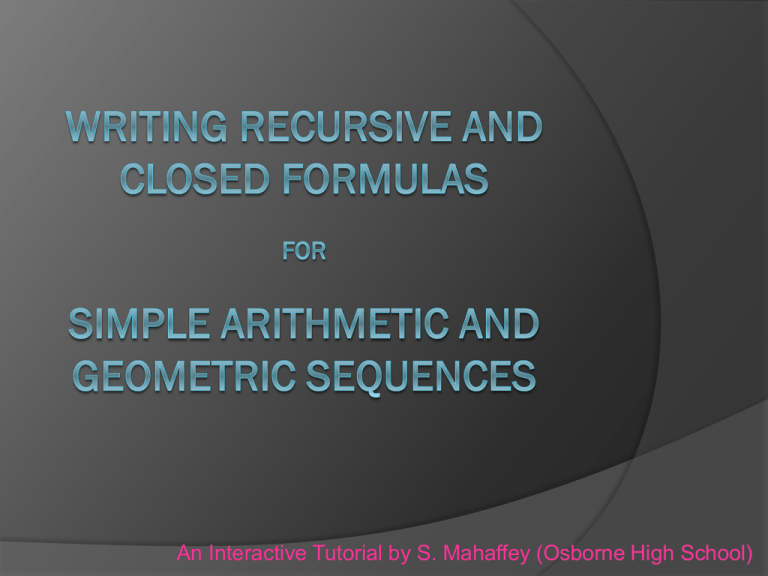
An Interactive Tutorial by S. Mahaffey (Osborne High School)
Sequences are functions. They are made up
of terms that go in a specific order.
The position of each term in the sequence is
called n. For the 5th term, n = 5. For the 8th
term, n = 8.
Each term is called an (pronounced “a sub n”).
Consider the sequence 2, 4, 6, 8, …
The first term is called a1, “a sub 1”. For this
example, a1 = 2.
The second term is 4, so a2 = 4.
The third term is 6, so a3 = 6.
The fourth term is 8, so a4 = 8.
The nth term is called an.
Consider the sequence 15, 20, 25, 30, 35, …
What is a1?
What is a3?
What is a5?
15
20
25
30
35
click
click
click
click
click
15
20
25
30
35
click
click
click
click
click
15
20
25
30
35
click
click
click
click
click
The domain of a sequence is it’s n values.
Since n is just the position of the term,
then the domain is the whole numbers 1,
2, 3, 4, etc.
The range of a sequence is it’s an values,
or terms.
Which is the correct domain and range for the
sequence 3, 10, 17, 24, …
D:{1,2, 3, 4,…}
R:{3, 10, 17, 24,…}
D:{3, 10, 17, 24,…}
R:{1, 2, 3, 4, …}
Click here
Click here
Sometimes the terms of the sequence
are not listed. Instead, you are given an
equation.
If this is the case, you can find the first
term by letting n=1, and the second term
by letting n=2, and so on.
Find the domain and range of the
sequence an = 3(n-1) + 2.
First, let’s write out the first 4 terms:
a1 = 3(1-1) + 2 = 3(0) + 2 = 2
a2 = 3(2-1) + 2 = 3(1) + 2 = 5
a3 = 3(3-1) + 2 = 3(2) + 2 = 8
a4 = 3(4-1) + 2 = 3(3) + 2 = 11
So, the domain is {1, 2, 3, 4, …} and the
range is {2, 5, 8, 11, …}
Find the domain and range for
an = 2(n-1) + 10
D: {1, 2, 3, 4, …}
R: {2, 4, 6, 8, …}
Click here
D: {1, 2, 3, 4, …}
R: {10, 20, 30, 40, …}
Click here
D: {1, 2, 3, 4, …}
R: {10, 12, 14, 16, …}
Click here
Find the domain and range for
an = -4(n-1) + 1
D: {1, 2, 3, 4, …}
R: {-2, -4, -6, -8, …}
Click here
D: {1, 2, 3, 4, …}
R: {1, -3, -7, -11, …}
Click here
D: {1, 2, 3, 4, …}
R: {-4, -8, -16, -32, …}
Click here
Find the domain and range for
an = 5∙2(n-1)
D: {1, 2, 3, 4, …}
R: {5, 10, 20, 40, …}
Click here
D: {1, 2, 3, 4, …}
R: {5, 10, 15, 20, …}
Click here
D: {1, 2, 3, 4, …}
R: {1, 10, 100, 1000, …}
Click here
In the last 3 examples, the sequences
were given as formulas and you had to
calculate the terms.
Now, we’re going to focus on how to
write the formulas when you are given
the terms.
There are two types of equations we’ll
be looking at in this tutorial.
The first type of formula is called a
recursive formula.
The second type of formula is called a
closed formula.
Recursive formulas are the easiest to write.
Each term is defined by the term that comes before it. (The
previous term).
Recursive formulas have 2 parts:
define the first term
define the next term by its relationship to the previous term.
For example, in the sequence 90, 95, 100, 105, … the first term is
90 and the next term is five plus the previous term.
In the sequence 14, 12, 10, 8, … the first term is 14 and the next
term is two minus the previous term.
In the sequence 1, 2, 4, 8, 16, … the first term is 1 and the next
term is 2 times the previous term.
Recursive formulas are written almost exactly
like you’d say it in English.
But instead of writing out phrases like “the next
term”, you’ll use these math symbols instead:
English
The next term
Math
Symbol
an
The previous term
an-1
Write the recursive equation for the series
9, 11, 13, 15, …
Identify the pattern:
The first term is 9
The next term is equal to the previous term plus 2.
Write the equation:
a1 = 9
an = an-1 + 2
Write the recursive equation for the series
25, 30, 35, 40, 45…
Identify the pattern:
The first term is 25.
The next term is equal to the previous term plus
5.
Write the equation:
a1 = 25
an = an-1 + 5
Write the recursive equation for the series
10, 9, 8, 7, 6…
Identify the pattern:
The first term is 10.
The next term is equal to the previous term
minus 1.
Write the equation:
a1 = 10
an = an-1 - 1
Write the recursive equation for the series
3, 6, 12, 24, 48…
Identify the pattern:
The first term is 3.
The next term is equal to the previous term
times 2.
Write the equation:
a1 = 3
an = an-1 ∙ 2
You try:
Choose the correct recursive formula for
the sequence 3, 7, 11, 15, 19, …
a1 = 3
an = an+1 + 4
a1 = 3
an = an-1 + 4
a1 = 4
an = an+1 + 4
a1 = 4
an = an-1 + 4
You try:
Choose the correct recursive formula for
the sequence 19, 15, 11, 7, 3, …
a1 = 19
an = an-1 + 4
a1 = 4
an = an-1 + 19
a1 = 19
an = an-1 - 4
a1 = -4
an = an-1 - 19
You try:
Choose the correct recursive formula for
the sequence 7, 14, 28, 56, 112, …
a1 = 7
an = an-1 ∙ 2
a1 = 7
an = an-1 + 7
a1 = 2
an = an-1 + 7
a1 = 2
an = an-1 ∙ 7
You try:
Choose the correct recursive formula for
the sequence 1, 8, 64, 512, …
a1 = 8
an = an-1 ∙ 8
a1 = 1
an = an-1 + 82
a1 = 8
an = an-1 ∙ 1
a1 = 1
an = an-1 ∙ 8
Recursive formulas are easy to write, but if you
want to find the 50th term, a50, you have to
know the first 49 terms. This can be time
consuming.
With closed formulas, you can easily find the 50th
term (n = 50). The formula uses the variable n
instead of an-1 (which is the value of the
previous term).
So, if you want the 10th term, then n=10. If you
want the 20th term, then n=20…
When you add or subtract to get to the next term, then
you have an arithmetic sequence:
To write a closed formula, start with the
recursive formula:
a1 =
an = an-1 +
Then rearrange the equation to get the closed formulas:
an =
(n-1) +
Arithmetic:
Recursive
a1 = 3
an = an-1 + 4
Closed
an = 4 (n-1) + 3
Find the 101st term of the sequence 2, 6, 10, 14, …
First write the recursive formula (The first term is 2 and each
additional term is the previous term plus 4)
a1 = 2
an = an-1 + 4
Next, write the closed formula:
an = 4(n-1) + 2
Finally, find the 101st term:
a101 = 4(101-1) + 2 = 4(100) + 2 = 402
Find the 51st term of the sequence 12, 15, 18, 21, …
First write the recursive formula (The first term is 12 and each
additional term is the previous term plus 3)
a1 = 12
an = an-1 + 3
Next, write the closed formula:
an = 3(n-1) + 12
Finally, find the 51st term:
a101 = 3(51-1) + 12 = 3(50) + 12 = 162
Find the 81st term of the sequence 100, 90, 80, 70, …
First write the recursive formula (The first term is 100 and each
additional term is the previous term minus 10)
a1 = 100
an = an-1 - 10
Next, write the closed formula:
an = -10(n-1) + 100
Finally, find the 81st term:
a101 = -10(81-1) + 100 = -10(80) + 100 = -700
Write the closed formula for the
sequence: a1 = 3
an = an-1 + 8
an = 8(an-1) + 3
an = 3(an-1) + 8
an = 8(n-1) + 3
an = 3(n-1) + 8
Write the closed formula for the
sequence: a1 = 15
an = an-1 - 2
an = 2(n-1) + 15
an = -2(n-1) + 15
an = -2(n-1) - 15
an = 2(n-1) - 15
Write the closed formula for the
sequence: 15, 20, 25, 30, …
an = 15(n-1) - 5
an = 15(n-1) + 5
an = 5(n-1) - 15
an = 5(n-1) + 15
Find the 101st term of the sequence:
8, 11, 14, 17, 20, …
a101 = 803
a101 = 308
a51 = 158
a100 = 305
Find the 51st term of the sequence:
81, 79, 77, 75, 73, …
a101 = -19
a51 = -19
a101 = -119
a51 = -119
When you multiply or divide to get to the next term, then
you have a geometric sequence:
To write a closed formula, start with the
recursive formula:
a1 =
an = an-1 ∙
Then rearrange the equation to get the closed formulas:
an =
∙
(n-1)
Geometric:
Recursive
a1 = 3
an = an-1 ∙ 4
Closed
(n-1)
an = 3 ∙ 4
Find the 9th term of the sequence 1, 2, 4, 8, 16, …
First write the recursive formula (The first term is 1 and each
additional term is the previous term times 2)
a1 = 1
an = an-1 ∙ 2
Next, write the closed formula:
an = 1 ∙ 2 (n-1)
Finally, find the 9th term:
a9 = 1 ∙28 = 1∙256 = 256
Find the 10th term of the sequence 2, 6, 18, 54, …
First write the recursive formula (The first term is 2 and each
additional term is the previous term times 3)
a1 = 2
an = an-1 ∙ 3
Next, write the closed formula:
an = 2 ∙ 3(n-1)
Finally, find the 10th term:
a10 = 2 ∙ 39 = 2 ∙19,683 = 39,366
Write the closed formula for the
sequence: a1 = 3
an = an-1 ∙ 8
(an-1)
an = 3 ∙ 8
an = 3 ∙ 8
(n-1)
(n-1)
an = 8 ∙ 3
(n-1)
an = 24
Write the closed formula for the
sequence: a1 = 15
an = an-1 ∙ 2
an = 2 ∙15
an = 30
(n-1)
(n-1)
an = 15 ∙ 2
an = 2(n-1) ∙ 15
Write the closed formula for the
sequence: 5, 15, 45, 135, …
an = 3 ∙5(n-1)
an = 5 ∙3(n-1)
(n-1)
an = 3 ∙5
an = 5 ∙ 3
(n-1)
Find the 8th term of the sequence:
1, 3, 9, 27, 81, …
a8 = 2,187
a7 = 729
a8 = 6,561
a7 = 2,187
Find the 10th term of the sequence:
2, 10, 50, 250, 1250, …
a10 = 1,953,125
a9 = 1,953,125
a10 = 3,906,250
a9 = 781,250

